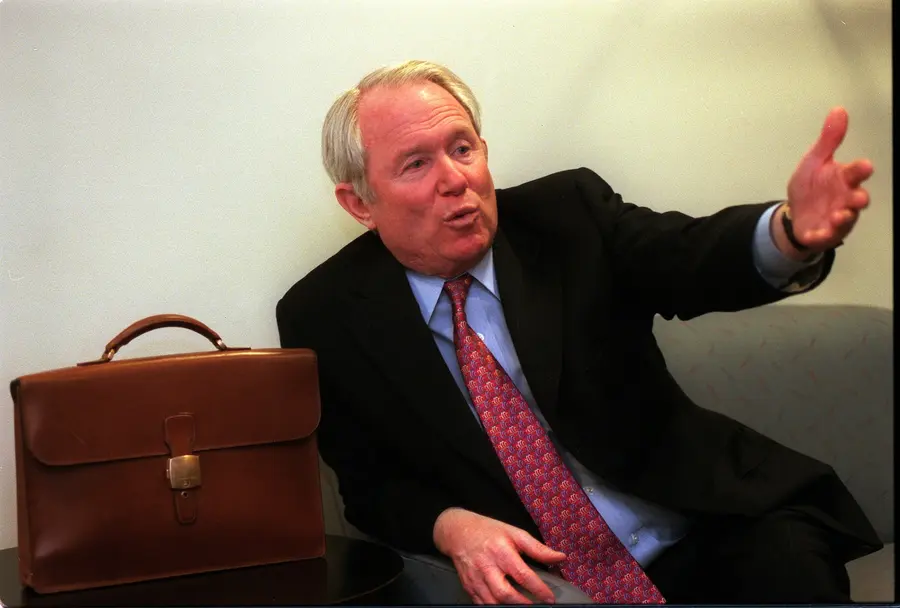Yesterday, Texas Attorney General Ken Paxton announced that he was opening an investigation into Powered by People, the political group founded by Beto O'Rourke, over allegations that it unlawfully funded Texas House Democrats who fled the state to block a redistricting vote. According to Paxton, the group may have violated state bribery laws by covering airfare, lodging, and other expenses for more than 50 lawmakers who left the capital to stall the session. O'Rourke has defended the move, calling it a necessary response to prevent what he views as authoritarian power consolidation.
Pretty much any time Beto is in the news for any reason, outlets—especially conservative ones—love to mention that Beto is married to a "billionaire heiress." The theory hinges on the fortune of Amy's father, William Sanders, a real estate mogul who was once described by Bloomberg as "the Warren Buffett of real estate." Some outlets have speculated that Sanders is worth as much as $20 billion.
It's a narrative that dovetails conveniently with attacks on Beto's image. After all, this is a candidate who has consistently positioned himself as a champion of working people—someone who skateboards through rallies, speaks out against corporate power, and frames his campaigns as grassroots movements. So when opponents claim he's bankrolled by extreme family wealth, the implication is clear: he's a phony. A rich kid pretending to be a populist.
But is that true? Is Amy O'Rourke the heir to a ten-figure fortune—and by extension, is Beto backed by family money that puts him in elite financial territory? Or is this clickbait fake news to fuel a narrative about privilege and political hypocrisy that doesn't hold up under scrutiny?

Chip Somodevilla/Getty Images
Who Is William Sanders?
William Sanders is indeed a legitimate real estate tycoon. Over the course of several decades, he founded, led, and sold some of the most influential property investment companies in American history. In fact, he's often credited as one of the founding architects of the modern REIT—Real Estate Investment Trust—structure, a model that helped transform real estate into an asset class Wall Street could package, scale, and trade like stocks.
William was born in Minnesota in 1941, but he was raised in El Paso, Texas. He attended Cornell University and graduated in 1964 with a degree from the College of Agriculture and Life Sciences.
LaSalle Partners
In 1968, William Sanders moved to Chicago, where he founded a real estate firm he named LaSalle Partners. While this isn't 100% confirmed, it's a strong bet that the name was inspired by LaSalle Street, the historic financial artery that runs through downtown Chicago. LaSalle Street itself was named after Robert Cavelier, Sieur de La Salle, a 17th-century French explorer and fur trader. The title "Sieur de La Salle" means "Lord of the La Salle estate." And if that sounds like some grand royal property—it's not. The La Salle estate was a modest farm, and Robert adopted the noble-sounding title in part to boost his credibility with patrons, monarchs, and colonial authorities during his expeditions in North America.
La Salle's most famous journey came in 1682, when he paddled a canoe from the mouth of the Illinois River down to the Gulf of Mexico. On April 9 of that year, he claimed the entire Mississippi River basin for France, naming it "La Louisiane" in honor of Saint Louis and King Louis XIV. That act is the reason the U.S. state of Louisiana bears its name today.
Anyways. Back to William Sanders…
Over time, LaSalle Partners became a major real estate advisory firm, helping corporations such as Ford Motor Company, Eastman Kodak, and Coca-Cola on how to manage, finance, and optimize their real estate holdings. This included helping companies lease office space, sell off underused industrial assets, develop headquarters properties, and structure investment vehicles. At a time when large corporations were beginning to treat real estate as a strategic asset rather than a static cost center, LaSalle's advisory work proved to be both innovative and extremely lucrative.
In 1987, William sold LaSalle to Japan's Dai-ichi Life Insurance Company for an estimated $65 million. This was shortly before the late-1980s real estate downturn, which made the timing particularly advantageous. FYI, $65 million in 1987 is the same as around $185 million today after adjusting for inflation.

William Sanders (Photo By Lyn Alweis/The Denver Post via Getty Images)
Jones Lang LaSalle
In 1999, LaSalle Partners merged with the London-based firm Jones Lang Wootton to form Jones Lang LaSalle, better known today as JLL. Headquartered in Chicago, JLL is now one of the largest commercial real estate services firms in the world, with offices in more than 80 countries. The company manages and leases hundreds of millions of square feet of commercial property, oversees multibillion-dollar development projects, and operates in sectors ranging from office and retail to logistics and data centers. Its clients include global corporations, real estate investors, and public sector institutions, making the JLL brand ubiquitous across major cities and commercial hubs.
Security Capital Group
After LaSalle, Sanders launched what would become his signature venture: Security Capital Group, a holding company that incubated a series of specialized REITs across different sectors—apartments, industrial warehouses, self-storage, office parks, and extended-stay hotels. At its peak in the late 1990s, Security Capital had interests in over 18 real estate companies and managed more than $20 billion in assets. In 2002, Sanders sold the company to GE Capital for $5.4 billion, a sum worth about $10.1 billion in today's dollars. According to SEC filings, Sanders personally received around $250 million in cash from that deal—equivalent to about $467 million today.
Verde Realty and the Paso del Norte Plan
In 2003, William co-founded Verde Realty, a private REIT focused on real estate opportunities along the U.S.–Mexico border. The company specialized in logistics and industrial properties in high-growth cross-border regions, including warehouse and distribution centers in Texas, New Mexico, and northern Mexico. Over the next decade, Verde built a substantial portfolio, including more than 100 industrial properties and tens of millions of square feet of space.
In 2010, Verde filed to go public, but ultimately withdrew its IPO plans. Two years later, in 2012, the company was acquired by Brookfield Asset Management in a deal worth approximately $886 million. Sanders reportedly owned about 6.4% of Verde, which meant his personal take from the sale was in the neighborhood of $22 million.
During this same era, Sanders became one of the leading voices behind the Paso del Norte Group, a private, invite-only coalition of business leaders from El Paso and Ciudad Juárez. The group's mission was to revitalize El Paso's aging downtown core. In 2006, it unveiled an ambitious redevelopment blueprint that called for new housing, commercial spaces, a cultural district, and civic infrastructure—all centered in and around the city's historic downtown.
Controversially, part of the plan included the use of eminent domain in a working-class area known as the Segundo Barrio, a historic neighborhood with deep cultural roots. Residents and local activists feared they'd be displaced to make way for upscale condos and retail development. Critics saw the plan as a "land grab," and Sanders—given his wealth, influence, and behind-the-scenes leadership role—became the lightning rod for opposition.
Adding more fuel to the controversy was the fact that Sanders's son-in-law, Beto O'Rourke, was serving on the El Paso City Council at the time. Although Beto recused himself from direct votes on land sales involving the plan, he spoke favorably about the vision and voted against a measure that would have preemptively banned the use of eminent domain. That decision drew sharp criticism and became fodder for political attack ads years later when O'Rourke ran for higher office.
In response to the backlash, Sanders initially said he would not invest personally in the redevelopment plan. But he later reversed that stance, agreeing to participate with a caveat: any profits he earned would be donated to a nonprofit dedicated to downtown revitalization. Ultimately, the Paso del Norte plan never fully materialized. Amid mounting public pressure, the city passed a resolution in 2006 forbidding the use of eminent domain for at least a year. Momentum slowed, and the sweeping redevelopment effort quietly fizzled out.
So… Is Amy O'Rourke a Billionaire Heiress?
Obviously, William Sanders is very rich. Over the course of his career, the companies he founded have sold for billions of dollars, throwing off hundreds of millions of dollars to William personally. He helped pioneer the REIT industry, managed a $20 billion portfolio at its peak, and earned a personal fortune estimated to be in the low nine figures. Depending on market conditions and private holdings, it's reasonable to estimate that Sanders's net worth has fluctuated somewhere between $300 and $600 million over the past two decades.
/2019/07/william-sanders.jpg)
/2018/11/Beto-ORourke.jpg)
/2025/11/Hussain-Sajwani.jpg)
/2018/02/gw.jpg)
/2022/09/Mohammad-Reza-Pahlavi.jpg)
/2014/06/john-portman-1.jpg)
/2019/04/rr.jpg)
/2009/11/George-Clooney.jpg)
:strip_exif()/2015/09/GettyImages-476575299.jpg)
/2020/02/Angelina-Jolie.png)
/2009/09/Brad-Pitt.jpg)
/2020/04/Megan-Fox.jpg)
/2020/01/lopez3.jpg)
/2018/03/GettyImages-821622848.jpg)
/2017/02/GettyImages-528215436.jpg)
/2009/09/Jennifer-Aniston.jpg)
/2020/06/taylor.png)
/2019/10/denzel-washington-1.jpg)
:strip_exif()/2009/09/P-Diddy.jpg)
/2009/09/Cristiano-Ronaldo.jpg)
/2019/11/GettyImages-1094653148.jpg)